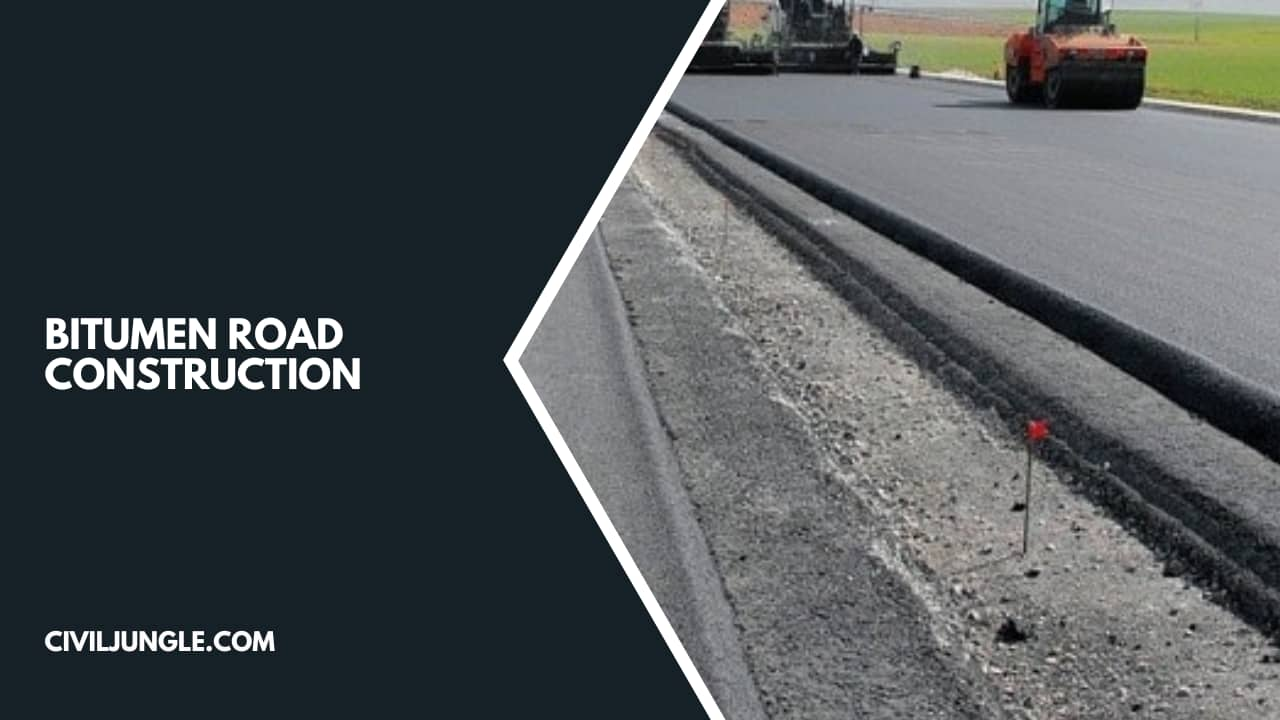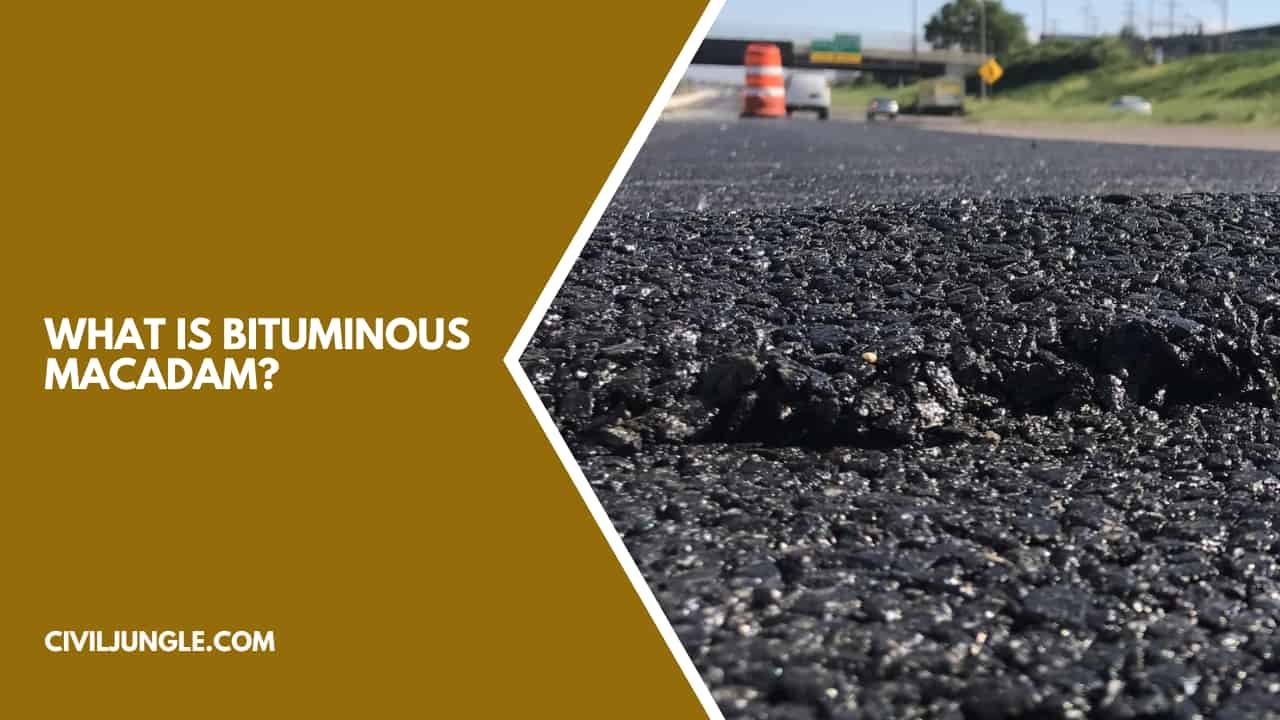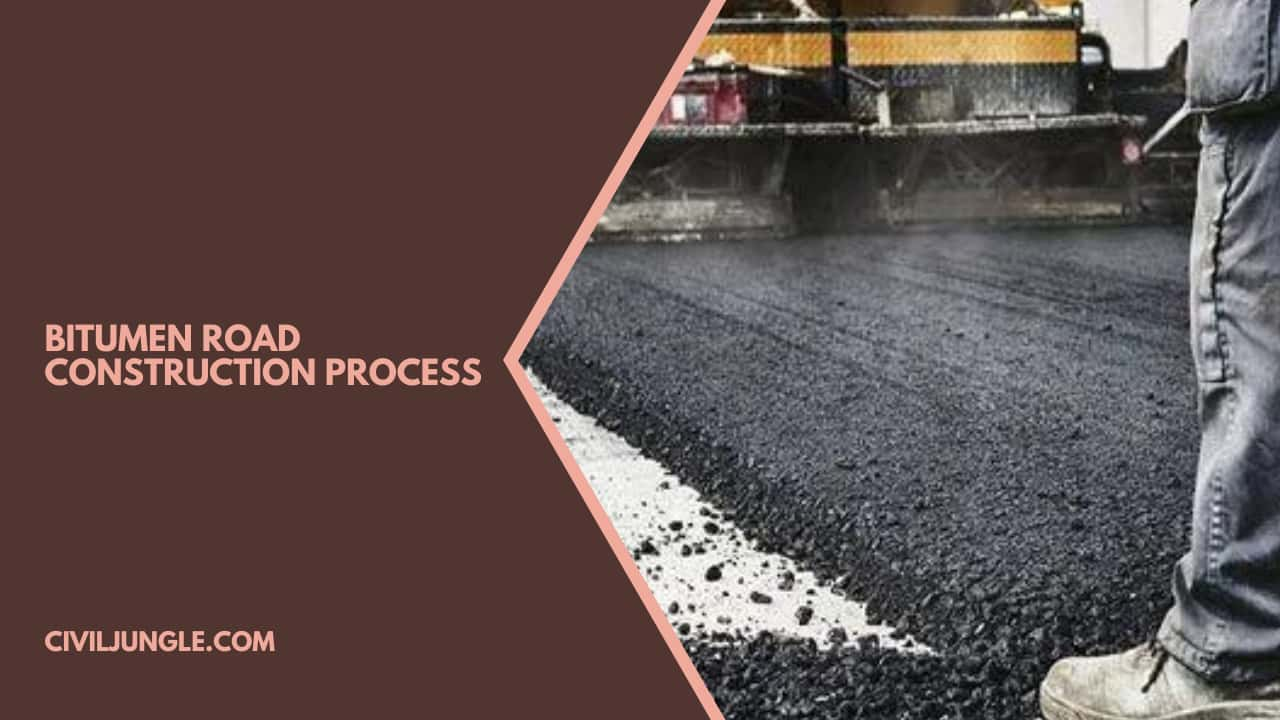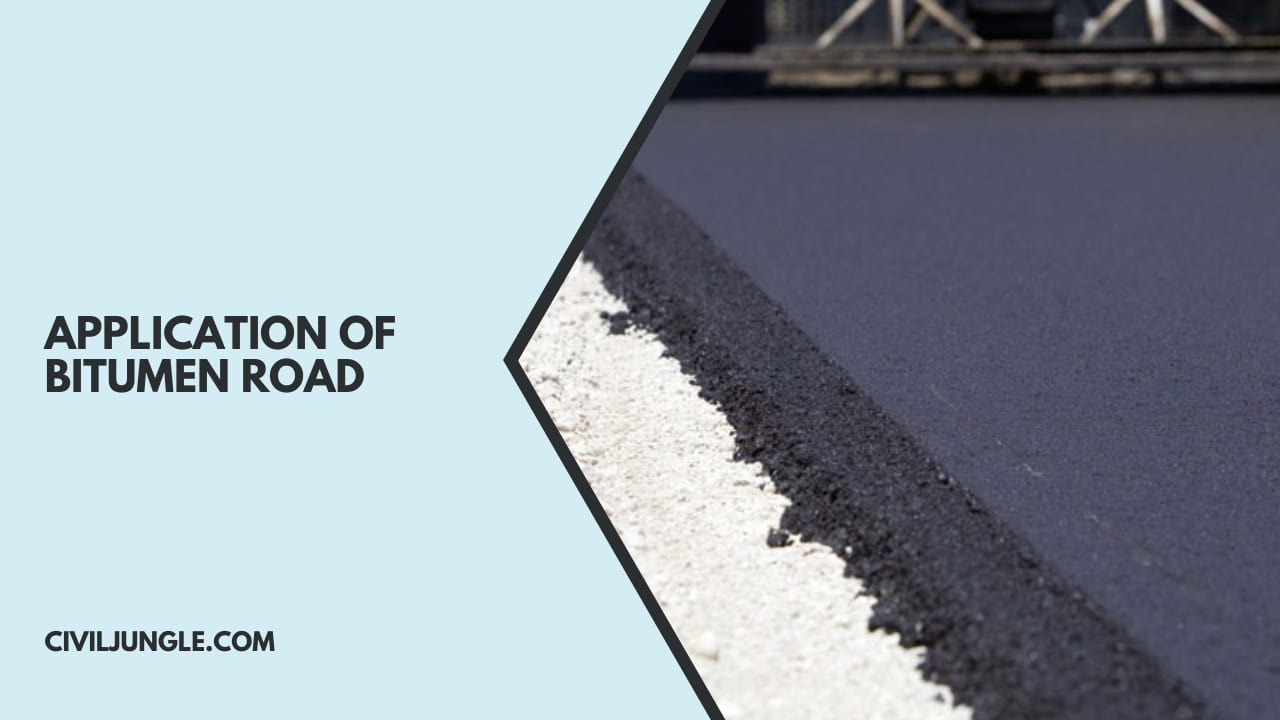Bitumen Road Construction.
Important Point
Bitumen road construction consists of different phases that are addressed, such as base course planning, bituminous coat application, bituminous mix placement, rolling and quality control, etc.
In various layers, such as the base course, binder course, and surface course, bituminous pavements are constructed.
These layers are constructed of various materials and the bituminous pavements have different functions.
Layers in a Bituminous Pavement.
Bituminous road has three layers. Which is as follows.
- Bituminous Base Course.
- Bituminous Binder Course.
- Bituminous Concrete Layer.
#1. Bituminous Base Course
- In a bituminous pavement, the base course layer consists of mineral aggregates mixed along with bituminous materials including such asphalt, stones as well as sands. This coating is used as the base for the positioning of the surface course or binder.
#2. Bituminous Binder Course
- An intermediate layer between the base course and the surface layer is the Binder course layer. That is the first layer in the case of a bituminous two-layer resurfacing.
- The bituminous binder course, also called the levelling course, is composed of a bituminous-aggregate mixture.
#3. Bituminous Concrete Layer
- A mixture of aggregates continually graded from maximum size to minimum size is a bituminous concrete layer (typically less than 25 mm to 0.075 mm aggregates).
- Enough bitumen is applied to the blend such that it is essentially impervious to the compacted concrete mix and has reasonable transverse and elastic properties.
Also, Read: What is Bitumen And Bitumens Types
What Is Bituminous Macadam?
Bituminous Macadam (BM) consists of crushed aggregates and bituminous binder heated and mixed in a hot mix plant at specified temperature, transported to the construction site, laid with a mechanical paver and compacted by a roller.
The BM is laid in a compact thickness of 50 to 100 mm. two different gradations of aggregates have been suggested by the IRC to provide open-graded mixture suitable for base course of highway pavements.
Therefore the BM layer should be covered by a suitable surfacing course before exposing to weather or traffic.
In case there is a delay in laying appropriate bituminous layers ( such as binder course and/or surfacing course) above the BM layers as per the design, at least a seal coat should be applied to prevent Ingress of water during unexpected rains and possible damaged to the BM layer.
With regard to load dispersion properties and toughness, the BM base course is known to be far superior to other forms of base course materials such as penetration macadam, WMM or WBM, providing the overall structural design satisfies the exact specifications at the location.
In terms of the granular base course layer, the equivalence ratios of the BM base course are assumed to be 1.5 m; in other words, one unit thickness of the BM base course layer is considered equal to 1.5 unit thickness of the granular base course layer and therefore of the construction methods of penetration.
Also, Read: Ductility Test of Bitumen | Three Different Methods of Ductility Testing
Bitumen Road Construction Process:
The initial surface is prepared by fixing the potholes or rust if any. At least a week before the surface course is laid, Premix chippings fill out the defects.
If the current pavement is extremely high, a sufficient bituminous levelling course of thickness is offered to lay a bituminous concrete surface course on a binder course instead of directly laying it on a WBM.
It is preferable to lay AC layers over a bituminous base or binder route. A bitumen tuck coat is applied at 6.0 to 7.5 kg per 10 sq.m area, which can be increased to 7.5 to 10 kg for a non-bituminous base.
In a hot mixing plant with the necessary power, the premix is prepared with the desired quality control. It is possible to heat the bitumen up to 150-177 deg C and the aggregate temperature does not vary from the binder temperature by more than 14 deg C.
The hot mixed material is obtained by the transporters from the mixture and delivered to the site at a temperature of 121 to 163 degrees C by a mechanical paver. The camber and the layer thickness are checked correctly.
In the strength of the resultant pavement structure, the regulation of the temperatures during the mixing and the compaction is of considerable importance.
A mixture is thoroughly compacted by rolling at a pace of not more than 5 km per hour after it is put on the base course.
The initial or breakdown rolling is done with a roller of 8 to 12 tons and the intermediate rolling is done with a pneumatic fixed wheel roller of 15 to 30 tons with a tire pressure of 7 kg per sq.cm. With water, the wheels of the roller are kept moist.
The amount of passes required depends on the layer’s thickness. On the following day, rolling in warm weather tends to increase the density if the original rolling was not sufficient. Final rolling or finishing is carried out by a tandem roller of 8 to 10 tonnes.
Quality control of bituminous concrete construction.
In order to ensure the consistency of the resultant paving mixture and the pavement surface, regular inspections are carried out at the site.
- Grading Aggregate.
- Bitumen Grade.
- Aggregate Temperature.
- Temperature During Blending and Compaction of the Paving Mix.
At least one sample of a blend discharged by a hot mixing plant every 100 tonnes is obtained and tested for the above criteria. There are also Marshall tests performed.
A 3.0 m straight edge should be tested against the AC wall. The longitudinal undulations should not exceed 8.0 mm and the number of undulations of more than 6.0 mm should not exceed 10 undulations of 300 m in length. There should be no undulations in the cross-traffic profile exceeding 4.0 mm.
Advantage of Bitumen Road:
- It does not use any joints; it thus offers a flat surface for riding. As compared to concrete pavements, it also has less sound pollution. In the bituminous pavement, wear and tear become less, thereby preserving the smoothness.
- A gradual process is a deformation and the failure of the bituminous pavement. The asphalt paving exposes delicate defects.
- They have the choice of being easily restored. In reversing the route for traffic, they do not consume time; as they set fast.
- This helps to carry out staged construction in a situation where challenges are met with fund limitation or traffic prediction problems.
- Compared to concrete paving, the initial expense and total maintenance cost of bituminous pavement are smaller.
- They are resistant to high melting temperatures and are not impacted by de-icing materials.
Also Read: bitumen vs tar
Disadvantage of Bitumen Road:
- Bituminous surfaces are less durable.
- Compared with concrete paving, poor tensile strength.
- Extreme weather and inappropriate weather conditions tend to render slippery and porous bituminous pavement.
- Bitumen with impurities can cause soil contamination, hence the melting of ground water. In small quantities, it may have hydrocarbons.
- During building and service life, blocking of pores and drainage routes.
- Further salting-to stop snow in the winter season.
- High building costs during extreme temperature conditions.
Application of Bitumen Road:
- Bitumen is a by-product of the method of distilling crude oil. Crude oil itself is a hydrocarbon composition. Petrol, diesel, high octane oils, and gasoline are the main items available.
- Bitumen is left behind as these oils are refined from crude oil. Further treatment of by-products produces pure bitumen to make it clean from impurities.
- Although the primary demand for goods is of paramount significance to society, the survival of bitumen as a commodity by product is long. This is used as a modern construction material by product, without looking after any other fresh materials.
- Bitumen’s physical and chemical properties are observed to be a function of the level of load, temperature, and loading length. That is a substance that is thermoplastic and viscoelastic.
- These dependencies allow one to genuinely enter road traffic so that the properties of a bitumen mix can be varied depending on the measured stress levels. This bitumen flexibility, depending on the path use, results in a wide range of bitumen mixes.
- The fact that bitumen has a desirable melting point, which effectively assists in both surface dressing and wearing resistance, is highly appreciable.
- The bitumen melting point should not be too high so that it can quickly be melted during the pavement laying process. Around the same time, bitumen has a melting point, which under high temperatures will not cause the already cast path to melt and distort.
- Although the bitumen melting point is favorable, it can be melted back to its original condition. This is called the method of asphalt recycling.
- Instead of taking them to landfill sites, the torn-up asphalt parts are brought back to the recycling facility. It is possible to reuse this recycled blend. If required, to keep the mix live again, the old bitumen is blended with new bitumen and new aggregates.
- It is free from hydrocarbons and thus not harmful, as explained in the processing of bitumen. To get free of organic materials as well as impurities, the substance is refined to the maximum.
Bitumen Road
Asphalt bitumen is a binding organic material made from the by-products of refined crude oil. It is used in road construction because it is easy to produce, reusable, non-toxic, and a strong binder.
Bitumen Road Construction
Bitumen is a material obtained by fractional distillation of crude petroleum as an end product. Bituminous materials were used for the construction of roads, preserving timber, and for waterproofing stone walls. Nowadays, they are extensively used for surfacing of road and airport pavements.
Bituminous Road Layers
#1. Bituminous Base Course.
- Base course layer in a bituminous pavement consists of mineral aggregates such as gravel, stones and sands bonded together with bituminous materials.
#2. Bituminous Binder Course.
- Binder course layer is an intermediate layer between the base course and surface layer.
#3. Bituminous Concrete Layer.
- Bituminous concrete layer is a mixture of aggregates continuously graded from maximum size to minimum sizes (typically less than 25mm to 0.075mm aggregates)
Bituminous Macadam
A pavement constructed by spreading two or more layers of crushed stone on a suitable base and pouring a bituminous binder on each.
Pavement Road
A road surface (British English), or pavement (American English), is the durable surface material laid down on an area intended to sustain vehicular or foot traffic, such as a road or walkway.
Bitumen Road Construction Process
- Demolition and Removal.
- Grading and Sloping.
- Prepare the Sub Base.
- Binder and Surface Course.
- Install New Asphalt Surface.
- Butt Joints and Transitions.
- To Complete the Project: Final Roll.
Advantage of Bitumen Road
Asphalt pavements are: Safe Asphalt pavements offer high skid resistance and provide high contrast in color between asphalt pavement and road markers, giving drivers better road visibility in any weather condition. Reduced wear and tear on vehicles due to fewer bumps in the road brings down vehicle operating costs.
Disadvantage of Bitumen Road
- These are less durable and have low tensile strength.
- The bitumen road will slick and soft in extreme weather and improper weather conditions.
- To soils, bitumen with impurities can cause pollution.
- During extreme conditions of temperature, the cost of construction is high.
Bituminous Road
Asphalt bitumen is a binding organic material made from the by-products of refined crude oil. It is used in road construction because it is easy to produce, reusable, non-toxic, and a strong binder.
Bitumen Road Layers
There are 7 layers in the bitumen road including surface course, tack coat, binder course, prime coat, base course, sub base course and sub grade.
Bituminous Road Construction
Bitumen road construction consists of various steps such as preparation of base course, application of bituminous coat, placement of bituminous mix, rolling and check for quality etc. which are discussed.
Bm Full Form in Road Construction
Bituminous macadam (BM) shall consist of mineral aggregate and appropriate binder, mixed in a hot mix plant and laid with a mechanized paver. It is an open graded mixture suitable for base course. It is laid in a single course or in a multiple layers on a previously prepared base.
Bm in Road Construction
BM stands for “Base Layer Materials” and is a type of paving material used in road construction. It is typically made up of crushed rocks, gravel, or other aggregate materials that provide a strong foundation for roads and highways.
Bm Road Full Form
The full form of BM Road is “Bituminous Macadam Road.”
Bc in Road Construction
Bituminous Concrete (herein after referred as “BC”) is a type of construction material that is used to build highways, driveways, and parking lots. It is composed of a binding agent and a mixture of stone and other types of aggregate materials.
Bituminous Pavement
Bituminous concrete layer is a mixture of aggregates continuously graded from maximum size to minimum sizes (typically less than 25mm to 0.075mm aggregates). Sufficient bitumen is added to the mix so that the compacted concrete mix effectively impervious and has acceptable dissipative and elastic properties.
Bitumen Road Construction Layers
The total number of bitumen road construction layers typically includes the following:
- Subgrade
- Sub-base
- Base Course
- Binder Course
- Wearing Course
Bt Road Full Form
Bituminous(BT) Road Construction||Road Construction Process.
What Is Bc in Road Construction?
Bituminous Concrete(BC)
Difference Between Bituminous Macadam and Bituminous Concrete
Bituminous Macadam is a road construction material consisting of well-graded aggregates and bitumen binder, providing a relatively strong and durable road surface. Bituminous Concrete is a dense mixture of graded aggregates, filler materials, and a higher proportion of bitumen binder, offering a stronger, more durable, and smoother road surface. It is often used for high-traffic roads and highways.
Bitumen Bound Macadam
In Bitumen Bound Macadam, the aggregates used are typically well-graded and of specific sizes, such as crushed stone or gravel. The aggregates are mixed with bitumen, which acts as a binding agent, creating a cohesive mixture. This mixture is then laid and compacted to form the road surface.
Like this post? Share it with your friends!
Suggested Read –
- Smooth Wheel Roller
- Construction Steps
- Dressed Stones
- Difference Between Tied Column and Spiral Column | What Is Spiral Column | What Is Tied Column
- What Is Soil Vent Pipe | How Does Soil Stack Pipe Works | Soil Vent Pipe Material | Types of Plumbing System
- What Is Tie Beam | Tie Beam Details | Advantages of Using Tie Beam | Tie Beam Reinforcement | Why Are Use Concrete Tie Beam
- Emulsion Paint Vs Oil Based Paint | Purpose of Providing Paints | Properties of Good Paint | Properties of Good Paint | What Is Oil Based Paint
- What Are Weep Holes | Need for Weep Holes | Foundation Weep Holes | Types of Weep Holes | Weep Holes In Retaining Wall | Window Weep Holes
- What Is False Ceiling | Why We Need False Ceiling | Types in False Ceilings | Advantages & Disadvantage of False Ceiling | False Ceiling Installation Steps by Step
- What Are Plastic Roads | How to Make Plastic Roads | Who Invented Plastic Roads | First Man-Made Plastic Road | Advantages & Disadvantages of Plastic Roads
Originally posted 2023-06-09 15:38:09.









Leave a Reply